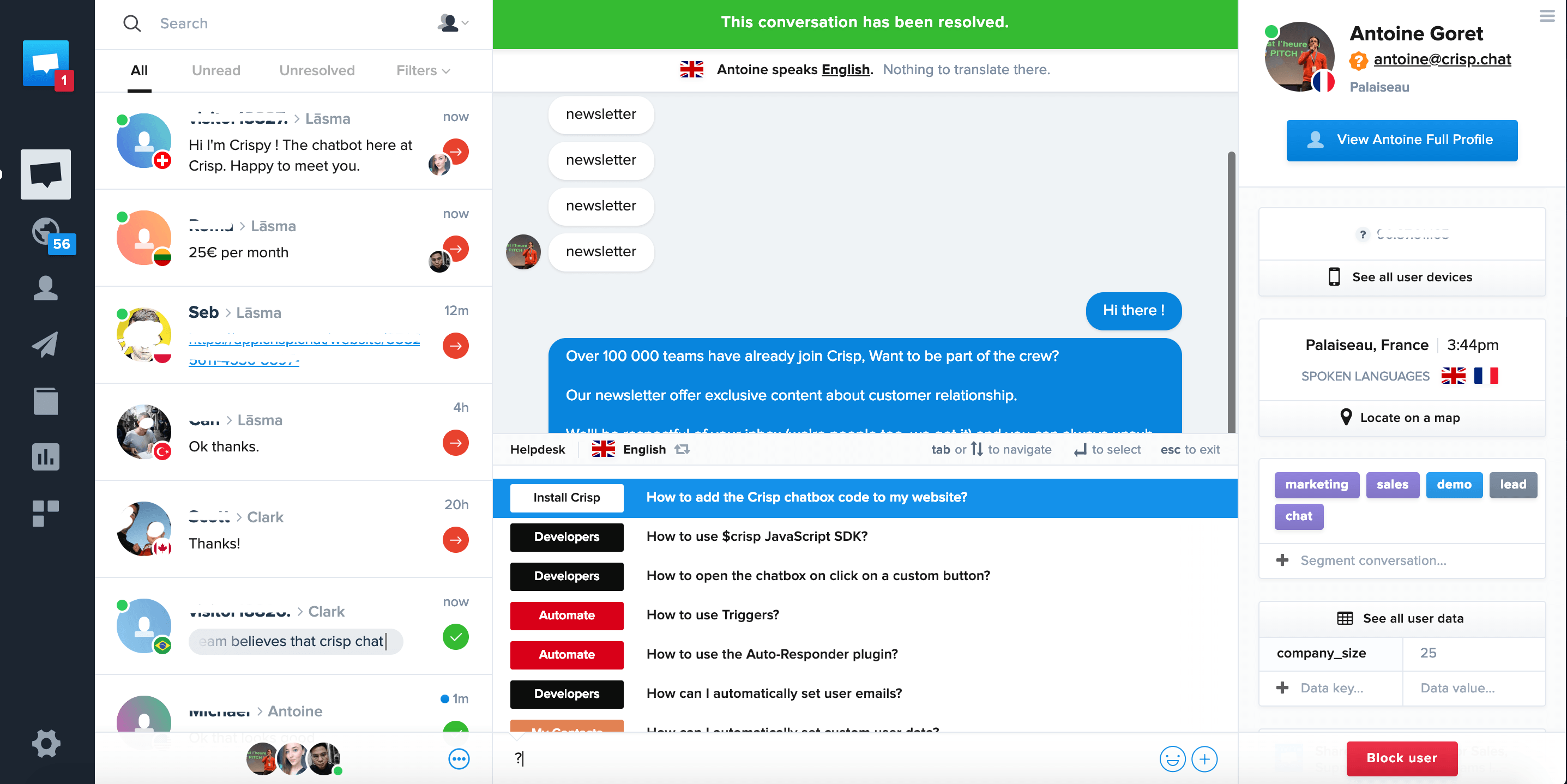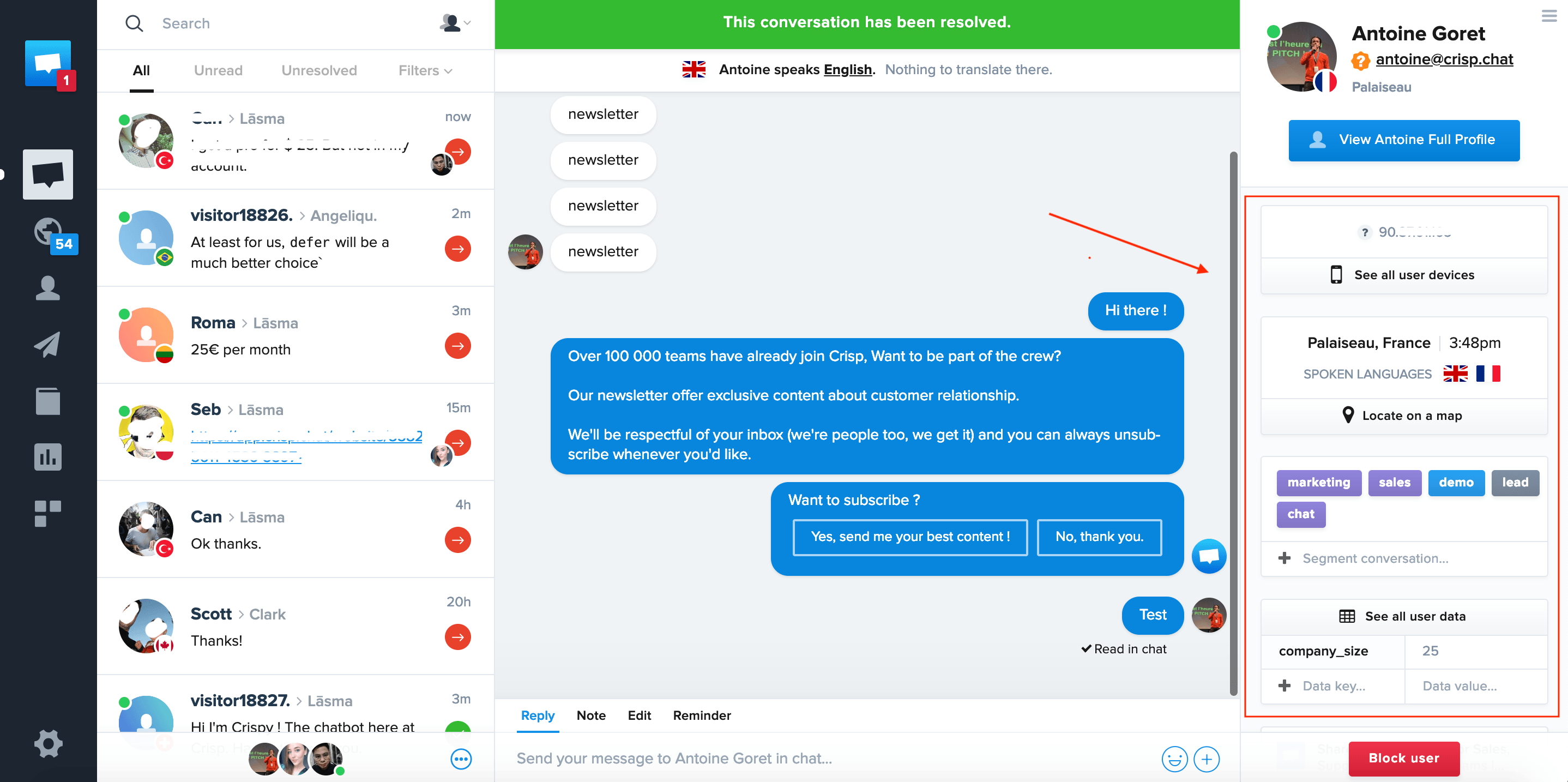Shared inbox is commonly seen as a way to share emails within an organization. At Crisp, shared inbox is much more than emails. We believe it should also integrate messages from social networks, Live Chat or phone and any other channel where customers can contact your company.
Dealing with an overwhelming list of communication channel has become a problem for a lot of B2B & B2C companies. With the rise of customers expectations, companies have to modify their communications channels to answer customers questions the fastest way.
8% of customers think that companies deliver delightful customer support experience
As multi-channel customer support has risen, companies had to adapt their organization to better scale their ability to answer questions from customers. One of the main innovation from the past years has been the appearance of multi-channel customer support software.
Innovation induces new process and generates problems for companies that try to fit with this new era.
The solution came from shared inbox software. As communication has now evolved and a lot of our B2B conversations are actually one-to-many or many-to-one. BCC's couldn't be a long-term solution. Shared inbox stepped in to help companies to centralize and unify customer support, customer knowledge and optimize allowed time to support customers questions.
So thanks to multi-channel customer support software, teams now avoid getting lost in the messy conversations generated by multi-channel customer service. They are able to share information about customers, to deal with multi-touch requests and optimize first response time to enhance users satisfaction.
Through this article you'll get :
- 5 reasons why your team should start to use a shared inbox within your organization 💥
- How to avoid shared inbox pitfalls 🤓
- Team inbox tips for Sales, Support & Marketing 📚
Why your teams should use a shared inbox?
Nowadays, Shared inbox software is a standard in modern companies as it helps business to be much more efficient at dealing with customers requests.
Answer leads & customers questions is time-consuming
As we've seen, multiple customers communication channels generates more and more request? It's becoming time-consuming for companies and teams.
Workers spent 7.4 hours/weeks checking emails 😱
Facing this problem, Shared Inbox software have integrated Shortcuts and Knowledge Base to let your team respond quickly to frequently asked questions.

Merge communication channel helps you to improve responsiveness
Sharing an inbox within a team or an organization can help you to improve responsiveness and therefore the one and only K.P.I "First Response Time".
Thanks to a shared inbox, you can now get your boss’ advice on this specific question or your team’s feedback on your response. Better, you might just want someone else to reply to the message as you are out of the office or just on holidays🌴.
This is where shared inboxes come in. They get all messages coming from outside of your company through a unified setup that your whole team can have access to. All messages are received within the same dashboard and it’s easier for everyone to respond to them. Giving your conversations the human touch they should have.
Thanks to a shared inbox, you can collaborate in real-time and improve internal collaboration inside each conversation to increase collaboration and response time.
Build a "zero inbox culture"
There are multiple definitions of what means inbox zero to people, departments, or companies. Nowadays, “Inbox Zero” is the bare minimum, and a central inbox with, say, less than 10 unresolved conversations every day should be your goal.
At Crisp, this is what we're reaching every day. Our goal is to have an average of 5 minutes of response time. Today we are at between 9 to 12 minutes.
Thanks to a shared inbox, you can easily reach this as every part of the company is gathered around the one and only dashboard which helps everyone to take part in the workflow.
It means that companies should have read every conversation and sent a message saying :" we've taken your request into account, we will get back to you shortly"
As you can easily mention someone from a specific department regarding a question that a customer has made, your teammates will get notified and should be able to answer questions immediately.
Building a "zero inbox culture" will increase customer satisfaction.
Improve customer knowledge
Team inbox helps you to centralize users questions. As they may vary a lot, you'll note that these are frequently the same that come back to your support, sales or marketing team.
Through a great multi-channel customer software, regarding the origin of the contact, you'll be able to increase knowledge regarding user profile :
- Location
- IP
- Languages
- Name
These are just simple examples of how you can enhance customer knowledge while offering excellent customer support.

Connect teams
As an organization, trying to fight for delivering delightful customer support, connecting teams should be a major goal towards excellent customer service. In fact, gathering your teams around one unique software will help you deconstruct silos and avoid lack of transparency and miscommunications.
Thanks to a shared inbox, you should be able to connect every department of your company : Support, Sales and Marketing.
Connecting your teams to one team inbox helps to reduce costs as you will not have to deal with multiple software.
Connecting your teams to one shared inbox helps you to increase efficiency as all the informations are gathered in one place.
While looking at a shared inbox software, you should definitely look at a tool that lets your whole company access to each other messages.
It builds trust, deconstruct silos, helps the company to better understand customer problem and get your company closer to your users so for us, Team Inbox is a no brainer for every company
How to avoid Team Inbox pitfalls?
Using a shared inbox can lead to some mistakes that can have a big impact on your customer relationship. With these few advices, you'll be able to counter shared inbox pitfalls and take the most out of them.
Prioritize conversations
By gathering data on your users, you are able to understand whom you are talking to. So if your operators, your sales team or marketing know that they are dealing with a hot customer or lead, well they'll have to do their maximum to answer him and increase customer satisfaction.
In order to prioritize conversations, you can push data from your CRM to your shared inbox or simply tag conversations automatically through a Live Chat for example.
Using automation to prioritize conversation is a great way to deal with high-level ticket vs low level. It will help you to create "fast lanes" support and build increasing returns on your pipelines.
Use private notes
A shared inbox is all about collaborative work and collaboration means that you must be able to share data and knowledge about customers.
In order to not lose any information, you should be able to write private notes that lets your colleagues aware of the content of the conversations and what the customer or the lead is expecting for.
For example, at Crisp, we use "/note" at the beginning of our messages to write a private note on a conversation.
Add a confirmation message before sending emails
Sending an email through a shared inbox can sometimes be complex and a mistake is common so you should always double-check the content of your message.
To avoid this, please ensure that you can set a confirmation message when you're about to send an email through the chatbox.
Always acknowledge customer support requests
Sending a receipt to customers' questions is a great way to prevent users' frustration regarding the answer they are waiting for.
Customer expect businesses to answer their question within one hour
For most of your customers, good support means quick answers so you should be able to improve and track the first response time or average response time.
So a simple trick would be to send an acknowledgment that you've received the customer's request and if you can't respond immediately to the customer, then simply say: "we will get back to you".
Shared Inbox for Sales
- Get the context for every conversations
- Set reminders for follow-up on conversations
- Confirm every email you sends: no more mistakes
- Connect your team inbox with your CRM
- Auto-assign the right lead to the good sales rep based on users interaction
- Auto-assign segments to conversations to monitor customer journey
- Build transparency for your team
- Build your email templates to share it with your team using shortcuts
- Track work time for every customer using Zapier
- Sort your messages by view
Shared Inbox for Support
- Build a chatbot to automate first-level support and redirect customers to the right person/ department
- Define routing rules to assign support request to the right teams
- Categorize each conversation to build statistics upon customers requests
- Use analytics to spot hours and days where you have to improve first response time.
- Look for unassigned conversations
- Use private notes to share information between teams
- Adapt shortcuts to answer quickly to users requests
Shared inbox for Marketing
- Build routing rules to assign leads to the right segment
- Create chatbots to build a conversational experience
- Use shortcuts to create email & messages templates
- Mentions teammates to assign tasks
- Get reminders about follow-up on leads
Want to start using a shared inbox within your company?
Engage with us through the chat widget on your right!










